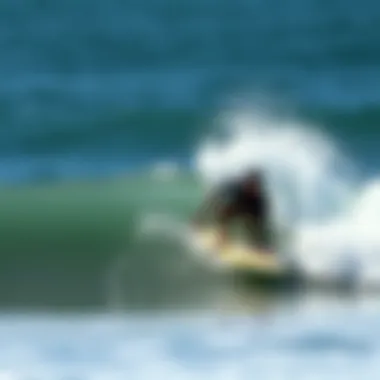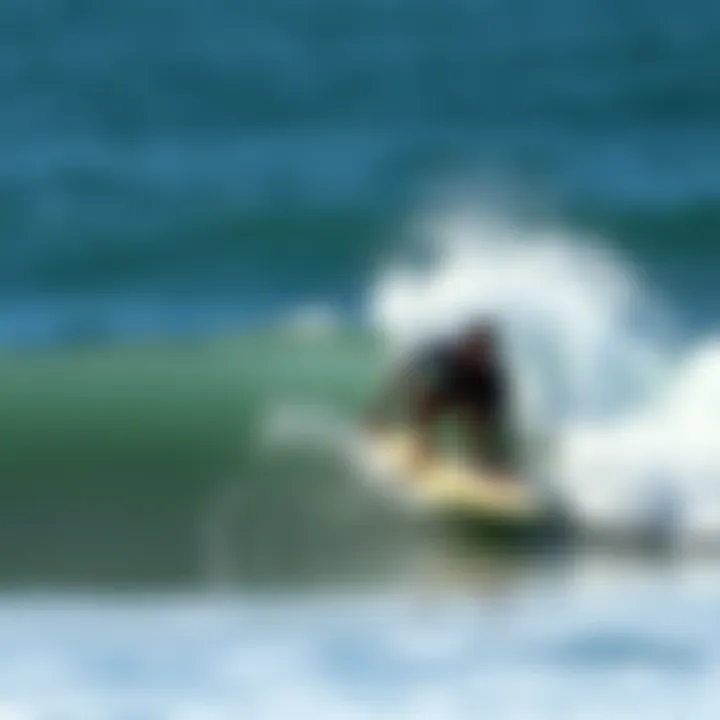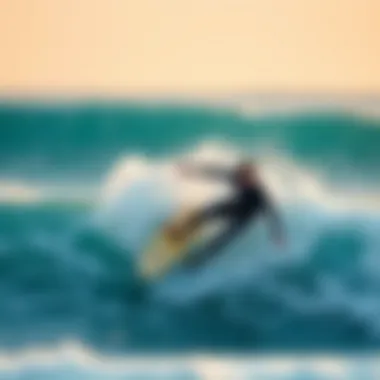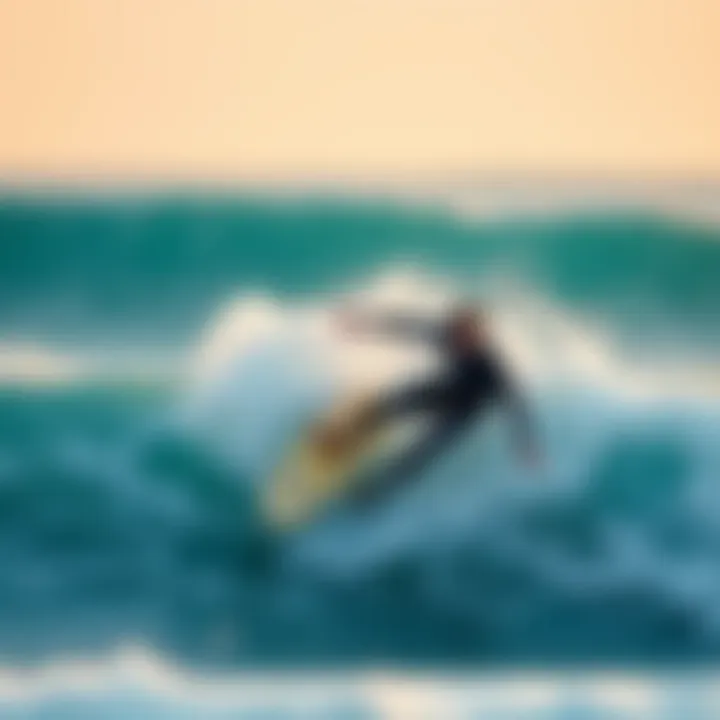Understanding Surf Reports: A Guide for All Levels


Intro
Surf reports are more than just numbers and charts; they are a window into the ocean's mood—a crucial tool for those who take their surfing seriously. With legions of surf enthusiasts hitting the beaches at dawn, understanding the nuances of surf reports can separate a thrilling ride from a washed-up day on the shore. The art of reading these reports combines science with an intimate knowledge of the waves, wind, and tides.
Why Surf Reports Matter
Accurate surf reports empower surfers to make informed choices about when and where to catch their next wave. Whether it’s a casual day at the beach or an intense session with friends, the right data can mean the difference between blissful riding and frustrating wipeouts.
Whether you're a novice dipping your toes in the water or a veteran navigating big waves, understanding surf reports is essential. The beauty is in the details—swell size, wind direction, and tide charts encapsulate the unpredictable nature of the ocean. Each component contributes uniquely to wave conditions, making it all the more important to decipher these reports before paddling out.
Different Sources and Methodologies
Today, surfers have a plethora of tools at their disposal to gauge the surf conditions. From local forecasts to advanced oceanography charts, the resources available can feel overwhelming.
- Local Surf Shops: Often, these shops have staff who live and breathe surfing. They provide forecasts and insights based on their firsthand experience with the waves.
- Online Platforms: Websites like Surfline and Magicseaweed offer real-time updates along with valuable historical data. Here, you can also find detailed tide tables and marine weather forecasts.
- Mobile Apps: Applications tailored to surfers can send notifications or alerts about changing conditions, making them a handy companion for any surf trip.
"Understanding your local waves can enhance your surfing experience! Dive deep into surf reports to ride better waves."
Each source brings its strengths, making it easier for surfers to stitch together an informed view of the ocean before heading out. This article will delve deeper into the components that make up effective surf reports, ensuring that you’re well-equipped for your next surf adventure.
Understanding Surf Reports
For any surfer, from the novice paddler to the seasoned wave rider, understanding surf reports is essential. These reports act as a compass, guiding surf enthusiasts to the best conditions the ocean has to offer. Mistaking surf reports is like heading into uncharted waters without a map; you might find a few waves, but you could miss the epic swells setting up just around the corner.
A surf report does more than simply tell you if there are waves. It encapsulates various factors that can significantly impact your surfing experience, such as wave height, swell direction, tide information, and wind conditions. Each of these components holds unique significance, contributing to what's often termed the 'surf experience.'
Understanding how to interpret these elements allows surfers to strategize better, ensuring they know when to grab their boards and hit the beach. Additionally, it arms them with the knowledge necessary to stay safe while enjoying the ocean.
In this section, we will delve into these intricacies, highlighting why grasping the makeup of surf reports is integral to enhancing your time spent on the water.
Definition and Importance
Surf reports summarize various conditions in coastal waters that can influence surfing activities. They typically detail size, quality, and conditions of waves, as well as additional essential factors affecting the surfing landscape.
Grasping the importance of these reports cannot be overstated. They help surfers make educated decisions. Having a solid understanding of the surf report means knowing exactly what to expect when you hit the water. Imagine arriving at the beach only to find the conditions are completely different than what you anticipated. Not only is that a disappointment, it can also pose safety risks.
Most importantly, accurate surf reports help surfers to be not just reactive but proactive. You can plan your schedule, choose the right spot, and even adjust your techniques based on the conditions outlined in your surf report.
Components of a Surf Report
Understanding surf reports involves dissecting their components, each crucial in its way to providing a thorough picture of surfing conditions. The primary elements include:
Wave Height
Wave height is one of the first metrics any surfer should consider. Typically measured from trough to crest, it indicates the size of the waves you can expect. Surf reports often categorize wave height into sections like "small," "medium," and "large."
- A key characteristic of wave height is its direct influence on your surfing safety and enjoyment. Smaller waves might be fantastic for beginners, while advanced surfers thrive on towering swells.
- The unique feature of wave height is its variability; it can change dramatically due to environmental conditions. This inconsistency is both a challenge and an opportunity for surfers. Small miscalculations can lead to missed opportunities for riding the perfect waves.
Swell Direction
Swell direction indicates where waves originate. It is typically expressed in degrees on a compass, providing surfers with insight on how waves will break at a given location.
- One key characteristic of swell direction is its impact on the surf spot's quality. Not every wave breaks the same; nuances in swell direction may mean one beach can provide favorable conditions while another might struggle.
- The unique aspect of swell direction is its predictability. Wind interacts with swells, affecting their size and energy. Thus, understanding swell direction can be incredibly beneficial for those looking to find that sweet spot for catching waves.
Tide Information
Tide information plays a significant role in how waves break and the overall quality of the surf. Tides are driven by the gravitational pull of the moon and sun, causing fluctuations in sea levels.
- A key characteristic of tide information is its cyclical nature, which surfers must learn to navigate. Certain tides may enhance the surf conditions at specific spots, leading to the best waves when timed correctly.
- The unique aspect of tides is how drastically they can change the ocean landscape. A spot that's prime at high tide might turn into a sandbar at low tide. Surfers must leverage this knowledge to adjust their strategies and maximize their session.
Wind Conditions
Finally, wind conditions are critical in shaping wave formation and overall surf quality. Winds can either enhance or diminish the quality of surf depending on their speed and direction.
- The key characteristic of wind conditions is their ability to influence wave size and surface texture; offshore winds can clean up waves, while onshore winds tend to make them choppy and harder to ride.
- A unique feature of wind conditions is their variability. Even in short spans, winds can shift, leading to significantly different surf experiences. This fluidity means surfers need to keep an eye on wind forecasts to catch the optimal conditions.
In summary, each of these components interplays with one another, creating a complex tapestry that surfers must untangle to make well-informed decisions. Understanding how to interpret the separate elements of surf reports not only sharpens your surfing skills, but also enhances your ability to appreciate the ocean itself.
Swell Dynamics
Swell dynamics play a central role in understanding surf conditions, serving as a critical factor for those eager to harness the ocean's power. Essentially, swell refers to waves generated by distant weather systems or storms that travel across the ocean, impacting surf conditions at various beaches. The characteristics of these swells not only determine wave quality but also influence surfers’ experiences significantly.
True surf enthusiasts know that recognizing swell dynamics can transform an average surfing day into an exceptional session. Thus, being adept at interpreting swell patterns fosters a deeper connection with the ocean, an essential aspect for anyone serious about riding the waves.
Formation of Swells
Factors Influencing Swell Size
The size of swells does not spring from randomness; it is meticulously shaped by several factors. One major aspect is wind speed, which can accelerate the formation of waves. When winds howl over long distances, waves gather momentum, creating larger swells. This is why storms far out at sea can lead to impressive wave heights days later at distant shores.
Another factor to consider is the fetch—the distance over which the wind blows—directly correlating to the swell size. A long fetch combined with strong winds often results in more powerful waves.
- Key characteristics:
- Wind speed and fetch are fundamental.
- Creates anticipation for surfers looking for big swells.
Yet, one ought to also consider seasonal changes that influence these factors. For instance, tropical storms tend to generate larger swells, which can be both exhilarating and intimidating for surfers.
Long-range Vs. Short-range Swells


When discussing swells, the distinction between long-range and short-range is vital. Long-range swells, originating from storms battered over vast ocean expanses, can lead to particularly clean and organized waves. Such swells typically offer smoother rides, ideal for advanced surfers seeking performance. Conversely, short-range swells, aggravated by local winds, can be choppier and unpredictable, creating conditions frequently favored by beginners keen on tackling smaller waves.
- Key characteristics:
- Long-range swells provide smoother rides.
- Short-range swells cater to varied skill levels.
In the end, it’s about balance. Long-range swells may offer the thrill of big waves, while shorter, localized swells can provide opportunities for growth in skills. Knowing when and where these swells will hit can lead to a satisfying surf experience.
Swell Analysis
Monitoring Swell Patterns
Monitoring swell patterns is crucial for an informed surf session. Surfers can analyze conditions by observing periods between swells. A longer period typically leads to better-quality waves, while shorter intervals might lead to choppy surf. This understanding helps surfers decide when to hit the water, aligning their time with optimal conditions.
- Key characteristics:
- Informs timing for surf sessions.
- Longer periods tend to correlate with better waves.
Furthermore, by utilizing tools such as surf forecasting websites, surfers can stay updated on real-time changes, which is invaluable when planning outings.
Identifying Optimal Surf Conditions
Identifying optimal surf conditions can separate a memorable day from a purely average one. Surfers keenly observe factors like wave height, wind direction, and tide effects, all intertwined in forming ideal conditions. Paying attention to these details not only enhances the riding experience but also ensures safety while on the water.
- Key characteristics:
- Focus on wind, tide, and wave interactions for best conditions.
- Essential for both safety and enjoyment.
Moreover, keeping an eye on local surf reports, as well as community insights, can bolster beginners' understanding while empowering seasoned surfers to refine their techniques. This collective knowledge acts as a guiding compass in the ever-changing tides of surfing.
"Understanding the ocean's moods through swell dynamics can not only improve your ride but can foster a deeper respect for the sea."
In summary, understanding swell dynamics equips surfers with necessary insight, allowing for a more tailored and pleasurable experience in and out of the water.
Tide Influence
Understanding tide influence is crucial for surfers looking to maximize their time in the water. Tides can significantly alter surf conditions, impacting both the quality of the waves and the surfing experience itself. The push and pull of the moon and sun creates a constant dance with the ocean's surface, shifting water levels and changing the landscape of the ocean floor. For surfers, being aware of how these tidal changes interact with other elements, like swell and wind, is essential for planning the best surfing sessions.
Tidal Phases Explained
High Tide Vs. Low Tide
When it comes to surfing, the difference between high tide and low tide can be like night and day. High tide, when the water level is at its peak, often produces more powerful waves. This occurs as the incoming water pushes towards the shore, causing the waves to break with greater force. This characteristic makes high tide popular for surfers who seek thrilling rides. On the other hand, during low tide, waves can become less consistent. As the water recedes, sometimes exposing sandbars or reef structures, this can lead to tricky conditions.
However, an interesting feature of low tide is how it can create unique breaks that aren't available during high tide. Each has its advantages and disadvantages, depending on the location. Understanding when to surf during these tides can enhance a surfer's overall experience and performance.
Spring Tides and Neap Tides
Now, looking at spring and neap tides adds another layer of complexity to surfing decisions. Spring tides occur roughly twice a month, when the sun and moon are aligned. This alignment results in the highest high tides and the lowest low tides, which can intensify surf, creating optimal conditions for those who know how to navigate the powerful waves. Following these periods, the neap tides, occurring when the moon and sun are at right angles, offer more moderate tidal shifts.
The neap tides might not produce the same thrill as springs, but they allow for a more forgiving surf environment. Surfers often find it easier to catch waves during these less intense times, as the currents aren't as strong. It's beneficial to familiarize oneself with these tidal phases to optimize surfing strategies.
Impact on Surf Quality
How Tides Alter Breaks
Tides can have a profound impact on the breaks at a particular surf spot. At high tide, certain reef breaks can become fully submerged, providing a different experience compared to low tide which can create sharper and faster waves. Surfers should familiarize themselves with the specific breaks' behavior at various tidal stages. A successful surf session often hinges on arriving at the right time, understanding how tides modify the breaks.
Adjusting Surf Strategies
With the tides actively shaping the surfing experience, adjusting strategies is vital. For instance, surfers may need to modify their approach, gear, or even their choice of waves based on the tide. A surfer pondering the right time to paddle out should consider not only the tidal phase but also its alignment with other conditions like swell and wind. This adaptability can lead to more successful and enjoyable sessions in the water.
"Timing is everything in surfing, and understanding the tides can make all the difference between a thrilling ride and a frustrating outing."
By diving deeper into the tide’s dynamics, surfers can better decide when to hit the waves and what to expect once they do. Becoming attuned to these shifts takes time, but knowledge and experience can indeed turn a good surf day into a great one.
Wind Conditions
Wind plays a pivotal role in shaping surf conditions. Understanding wind patterns is essential for surfers who wish to leverage the natural elements for an optimal experience. The careful observation of wind, particularly its direction and strength, helps enthusiasts predict wave quality and performance, making it a key focal point in any surfer’s planning.
Understanding Wind Effects
Onshore Vs. Offshore Winds
When dissecting wind influences in surfing, one can't overlook the distinction between onshore and offshore winds. Onshore winds blow from the sea towards the land. Generally, these winds create choppy surf which can muddle up wave faces, rendering them less appealing for riding. Conversely, offshore winds, which blow from the land towards the ocean, are seen as the golden ticket. They smooth the water's surface, allowing waves to break cleaner and more consistently.
Each type of wind has its unique characteristic. Basically, when the offshore winds are in play, the quality of waves can noticeably improve. So, for surfers looking to catch the perfect ride, monitoring when the wind shifts offshore can be crucial. However, offshore winds can also change quickly, leading to sudden conditions that might catch surfers unprepared.
- Advantages of Offshore Winds:
- Disadvantages of Onshore Winds:
- Clean wave faces
- Better barrel opportunities
- Longer rides
- Choppy and disorganized waves
- Reduced ride quality
- Increased difficulty in maneuvering
Wind Speed and Wave Formation
Wind speed is another vital factor in surf formation. Higher wind speeds can generate larger and more powerful waves. However, there's a fine line to tread here. Too much wind can also create rough conditions that may turn an anticipated surf session into a struggle. Usually, moderate winds are preferred for an ideal balance between wave power and surface clarity.
The impressive part about wind speed is its direct correlation with wave energy. As a surfer, knowing the wind speed can help in choosing the right time and place to paddle out. For instance, a light offshore breeze might be just what’s needed to elevate the surf quality just before a high tide.


- Benefits of Suitable Wind Speed:
- Drawbacks of High Wind Speeds:
- Enhancing wave height and shape
- Providing options for more surfing styles
- Achieving smoother conditions for high-performance tricks
- Potential for dangerous conditions
- Can lead to fatigue faster
- Difficult to maintain control on the board
Wind Forecasting Tools
Understanding wind dynamics is one thing, but practically applying that insight through forecasting tools is equally pivotal. Modern technology offers surfers a suite of options to keep tabs on wind conditions.
Using Weather Apps
Weather apps have become increasingly popular among surfers. These applications provide real-time updates on wind conditions, allowing surfers to plan their sessions with precision. They offer key features like predictive models and detailed geographical breakdowns that help users see exactly how wind conditions will change throughout the day.
The beauty of using weather apps is that they bundle all your needs into one portable package. From temperature to wind speed, surfers can access comprehensive data, streamlining the decision-making process for when to hit the waves.
- Advantages of Weather Apps:
- Potential Limitations:
- Immediate access to updated conditions
- User-friendly interfaces
- Provides local insights and trends
- Might not always be accurate
- Some apps may require premium subscriptions for full features
Localized Wind Reports
Localized wind reports are another excellent resource for surfers. Unlike broader meteorological data, these reports focus on specific locations, offering detailed assessments that pertain to local surf spots. Typically produced by local surfers or surf schools, these reports often include insights that technology alone may overlook.
These localized insights can make a significant difference in a surfer's experience. For example, a nuanced report may highlight specific challenges with certain spots based on recent wind shifts, allowing surfers to select the best conditions for their skill level and desire.
- Benefits of Localized Reports:
- Drawbacks:
- Tailored to specific surf locations
- Offers practical advice from experienced locals
- More reliable information on micro-climates affecting the surf
- May lack the comprehensive data offered by larger platforms
- Reliance on community contributions can lead to variability in quality
In summary, wind conditions are an integral part of the surfing landscape. From knowing how different winds affect wave quality to using forecasting tools effectively, gaining a thorough understanding here can substantially enrich a surfer's overall experience.
Regional Surf Variations
Understanding regional surf variations is pivotal for surfers who seek to refine their experience in the water. Each coastline possesses its own unique characteristics shaped by the geography, climate, and other factors that play a significant role in surfing dynamics. Recognizing these variations allows surfers to adapt their strategies, enhance their enjoyment, and stay safe while catching waves.
Analyzing Geographic Influences
Coastal Geography
Coastal geography refers to the physical features of a coastline that influence surfing conditions. This includes factors such as landforms, sediment composition, and the presence of natural obstacles like reefs and jetties. A distinct characteristic of coastal geography is its ability to shape wave breaks. For instance, a sandy beach might offer rolling waves, while a rocky shore can produce more challenging, steep breaks.
These geographical elements can determine the type and quality of surf one can expect at a location. Surfers often find themselves better suited to different types of breaks based on their skill levels. For example, beginners might thrive in the gentle waves at Santa Monica, while experienced surfers might prefer the treacherous reefs of Pipeline in Hawaii.
Advantages of recognizing coastal geography include:
- Safety: Knowing which waves to tackle can prevent accidents.
- Skill Development: Identifying suitable surf spots promotes improvement in techniques.
- Condition Awareness: Understanding how geography impacts wave formation can enhance decision-making.
Ocean Currents
Ocean currents are another critical aspect of coastal geography, affecting the surf environment significantly. These currents, which can flow in various directions and strengths, influence water temperature, wave patterns, and even sea life. A key feature of ocean currents is their ability to either enhance or diminish wave height depending on the tide and wind conditions.
For example, the California Current brings cooler water down the coast, creating a different climate and surf experience compared to the warm Gulf Stream along the East Coast. The local surfer might find that these temperature differences directly impact not just surfing conditions but also the presence of marine life.
Understanding how ocean currents operate provides several benefits:
- Real-time Adjustments: Surfers can adapt their timing based on current effects on waves.
- Enhanced Safety: Awareness of rip currents can prevent dangerous situations.
- Localized Knowledge: Surfers gain insights into the best times and places to hit the water.
Popular Surfing Destinations
Surfing is more than just a sport; it's a cultural experience defined by various local influences. Popular surfing destinations reflect not only the quality of waves but also the lifestyle and community of nearby surfers.
Local Surf Culture
Local surf culture encompasses the practices, beliefs, and traditions that shape the surfing experience in a particular area. This cultural aspect is crucial as it educates newcomers about local etiquette while fostering a sense of shared identity among surfers. Highlighting a community's surf culture can enhance respect among surfers and promote safety within the waters.
An advantage of understanding local surf culture is that surfers can better assimilate to the norms of a new destination. Knowledge of the location's unwritten rules, such as right of way and wave sharing, can provide newcomers with smoother interactions and experiences. Surf contests, beach cleanups, and other community events also enrich this culture, thereby fostering bonds among locals and visitors.
Unique Surf Conditions by Region
Different regions offer surf conditions that are as diverse as they are fascinating. Unique surf conditions arise from a combination of local wind patterns, ocean depth, and seabed topography influencing wave form and quality. For instance, areas like Jeffrey’s Bay in South Africa host world-famous right-hand point breaks, while the shores of Indonesia are known for their heavy reef breaks.
These unique regions allow surfers to experience a plethora of wave types, ranging from mellow beach breaks to hefty barrels.
The advantage of recognizing unique surf conditions lays in helping surfers map out their travels and surf schedules effectively. Surfers looking to explore can research spots that align with their skill level and preferences, ensuring they find the proper environment to enhance their surfing prowess. Moreover, being aware of the prevailing weather conditions can also contribute to a fulfilling surf experience.
Surf Report Sources and Tools
In the fast-paced world of surfing, having access to reliable information is key. Surf report sources and tools play an invaluable role in ensuring surfers make informed decisions. They can mean the difference between catching the perfect wave or spending a day gazing at a flat sea. Whether you're a curious beginner or a seasoned pro, understanding where and how to get surf reports can enhance your entire ocean experience.
Online Platforms and Services
Reliable Surf Forecast Websites
Reliable surf forecast websites are like having a trusty weathered friend who has surfed the spots time and time again. They amalgamate data from a variety of sources to give you a well-rounded view of surf conditions. A key characteristic of these platforms is their up-to-date, accurate forecasts. Sites like Magicseaweed and Surfline are popular choices because they present detailed reports that break down wave height, swell periods, and wind conditions.


One unique feature of these websites is the ability to view live webcam feeds directly from popular surf locations. This fosters a sense of connection and immediacy. That said, discrepancies can sometimes emerge when reports change based on real-time conditions, making it essential to cross-reference information.
Mobile Applications for Surf Reports
Mobile applications for surf reports offer convenience at your fingertips, turning your smartphone into a compact oracle of surf knowledge. These apps typically provide real-time notifications about changes in conditions, making them crucial for planning those early morning sessions. A notable aspect of applications like Windy or Surfline is their user-friendly interfaces, which allow quick and easy access to all the pertinent details.
One standout feature in many apps is the ability to customize alerts. Surfers can set notifications for specific conditions or times, ensuring they never miss the waves that matter most. However, reliance on mobile data can be a drawback in remote areas where service is spotty.
Community Contributions
User-generated Content
User-generated content has become a vital lifeblood in today's surfing culture. Many surfers share their own experiences and insights on platforms like Reddit or dedicated forums. This aspect allows real-time updates and reports from fellow surfers, offering perspectives that might not be captured by traditional report sources.
A key characteristic is the authenticity; user-generated insights can provide a more localized perspective that reflects the current surfing conditions as they experience them. Something special about this content is the personal touch and actual surfer feedback on local spots, which can be particularly beneficial for those new to an area or seeking to dodge the crowds. However, it can vary in reliability, so a discerning eye is required to separate hot tips from tall tales.
Local Surf Community Insights
Local surf community insights are golden nuggets of information that often go underappreciated. Engaging in local surf communities, either online or offline, grants access to knowledge from those who know a region best. This local wisdom encompasses everything from secret spots to nuanced weather patterns that may not be presented well in online forecasts.
What makes these insights important is their cultural relevance; it's not just about the waves but the vibe, etiquette, and local customs that can immensely enhance the surfing experience. Connecting with local surfers through social media platforms or surf clubs can lead to incredible networking opportunities, yet one must tread lightly and respect the local surf scene.
"The best surf reports often come from those who ride the waves day in and day out. Pay attention to the locals."
In summary, whether you’re using websites or apps or soaking in community insights, being well-informed is your ticket to maximizing every surf session. The goal is to blend various sources, ensuring you're equipped to make the best choices for each unique surfing scenario.
Applying Surf Reports
Understanding how to effectively apply surf reports can dramatically enhance both the enjoyment and safety of your surfing experience. Rather than just collecting data, it's about making informed decisions that elevate your time on the water. Evaluating reports requires a careful blend of knowledge, intuition, and awareness of the local conditions and dynamics of the surf environment.
Decision-making for Surfers
Planning Surf Sessions
Planning surf sessions hinges on careful interpretation of surf reports. By assessing wave height, period, and tide information, surfers can strategically choose when to hit the waves for the best experiences. Rather than blindly going out at any time, those who plan based on reports can minimize frustration and maximize enjoyment. A key characteristic of effective planning is knowing the best days for particular spots based on their unique break patterns, which often correlate with specific swells and tides.
This planning process is a beneficial choice because it allows surfers to align their schedules with favorable conditions. For instance, small swells may be ideal for beginners, while seasoned surfers might wait for larger, more powerful waves. However, the unique feature of planning surf sessions is the constant evaluation of changing conditions, which can lead to unforeseen challenges. The disadvantage could include missing out due to sudden shifts in forecasts, making it essential for surfers to remain flexible and attentive.
Safety Considerations
Safety considerations are paramount when applying surf reports. One main aspect here is understanding local hazards, like rip currents and other environmental risks, which are often noted in detailed surf reports. By focusing on the safety profile provided in these reports, surfers can choose locations that minimize danger while still offering good surf.
Recognizing safe surf conditions is important for surfers of all levels. This aspect is particularly valuable for less experienced surfers, as it guides them toward safer breaks and away from areas prone to hazards. A unique feature of focusing on safety is the tailored recommendations surf reports provide based on current conditions. For example, high waves on a strong day may suggest avoiding certain breaks altogether. The downside of this is that sometimes, what looks safe in a report might change quickly, making constant vigilance necessary.
Enhancing Surf Experience
Choosing Suitable Equipment
Choosing suitable equipment based on surf reports can greatly impact your performance and enjoyment. Knowing conditions such as wave size and type allows surfers to select the right board, whether that’s a longboard for small, mellow waves or a shortboard for steeper, more powerful swells. This is a key feature of getting the most out of your session, as the right board enhances paddling speed and allows for better handling in the water.
This aspect is beneficial because it not only boosts surfer confidence but also enhances their connection with the waves. A tailored choice of equipment can make the difference between a frustrating day and a productive one, allowing surfers to ride to their potential. Nonetheless, there’s the caveat that frequent equipment changes could require time to adapt, causing initial discomfort or less than effective performance.
Adjusting Techniques Based on Conditions
The final element to address is the need for adjusting techniques based on surf conditions. Recognizing how factors such as wind and tide influence wave behavior can help surfers refine their approach on the fly. For example, on windy days, a surfer might opt for more aggressive turns to maintain speed and control. The key characteristic of adapting techniques lies in a surfer’s ability to interpret immediate conditions and respond effectively, a skill honed over time.
This concept is particularly popular among seasoned surfers who often thrive in changing conditions, allowing them to push their limits. However, the unique attribute of this adjusting method is that it demands a high level of observation and quick decision-making, which may be tough for beginners. For novices, these rapid changes in approach could feel daunting, highlighting the importance of gaining confidence through practice and observation.
By applying surf reports thoughtfully, surfers of all abilities can elevate their time on the waves, ensuring they’re well-prepared and safe while making the most of each surf trip.
Future of Surf Reports
Understanding the future of surf reports is essential for both avid surfers and casual enthusiasts alike. As technology advances, so does the ability to gather, analyze, and present surf data, improving the quality of information available to surfers. Embracing the changes not only enhances surf forecasting accuracy but also fosters a deeper connection between surfers and ocean dynamics.
Technological Advancements
Data Analytics in Surf Forecasting
Data analytics is revolutionizing surf forecasting. By aggregating vast amounts of historical and real-time data, it gives surfers actionable insights into wave patterns and conditions. One of the key characteristics of data analytics is its ability to predict trends rather than just momentary conditions. This is a major benefit, allowing surfers to plan their sessions more effectively.
A unique feature of data analytics in surf forecasting is its integration with machine learning algorithms that refine predictions based on past datasets. However, while the advantages are substantial, like enhanced predictive power, there are challenges as well. Clean data collection is crucial, as inaccuracies can lead to misguided surf sessions.
Integration of AI in Surf Reports
The integration of AI in surf reports is making headlines, and for good reason. AI helps in refining predictions through advanced computational methods and can analyze patterns that might elude human observers. One key characteristic here is the capability to process external factors like weather systems that contribute to surf conditions. This makes it a beneficial choice for anyone serious about their surfing pursuits.
Unique features of AI integration include real-time updates provided directly to mobile devices, which keeps surfers informed even while they are out on the water. Although the upside is enticing, it's worth acknowledging that reliance on AI can sometimes lead to overfitting, where models become too tailored to specific data and fail to account for variability in ocean behavior.
Evolving User Engagement
Virtual Wave Pools
Virtual wave pools are redefining surfing experiences by offering controllable and consistent wave generation. The ability to create surf conditions that mimic those found in the ocean makes them an attractive option for training and leisure alike. Importantly, these pools provide a stress-free environment for beginners to learn. This controlled setting is particularly beneficial as it lowers safety risks.
However, a drawback is the cost associated with building and maintaining such facilities, making them less accessible to average surfers. Yet, the appeal for structured learning and practice cannot be overlooked as it fills a crucial gap in the surf community.
Online Monitoring Communities
Online monitoring communities have emerged as a cornerstone for surf enthusiasts. These platforms allow surfers to share conditions, tips, and forecasts with one another, becoming a living archive of real-time ocean information. One key characteristic is their community-driven aspect, enabling local surfers to share localized knowledge that is often absent from larger platforms.
Unique features of these communities include forums and interactive maps, which can enhance user engagement significantly. However, the optionality of information quality can be a concern, with misinformation potentially causing issues for users relying on community-generated forecasts. Overall though, these platforms foster camaraderie among surfers and improve the collective understanding of surf conditions.
It’s clear that as technology and community engagement evolve, so do the ways surfers interact with the ocean. By staying attuned to these advancements, enthusiasts can ensure they are always riding the best waves possible.
For more insights into the dynamics of surf reports, consider visiting relevant resources like Wikipedia on Surfing and community forums on Reddit Surfing.







